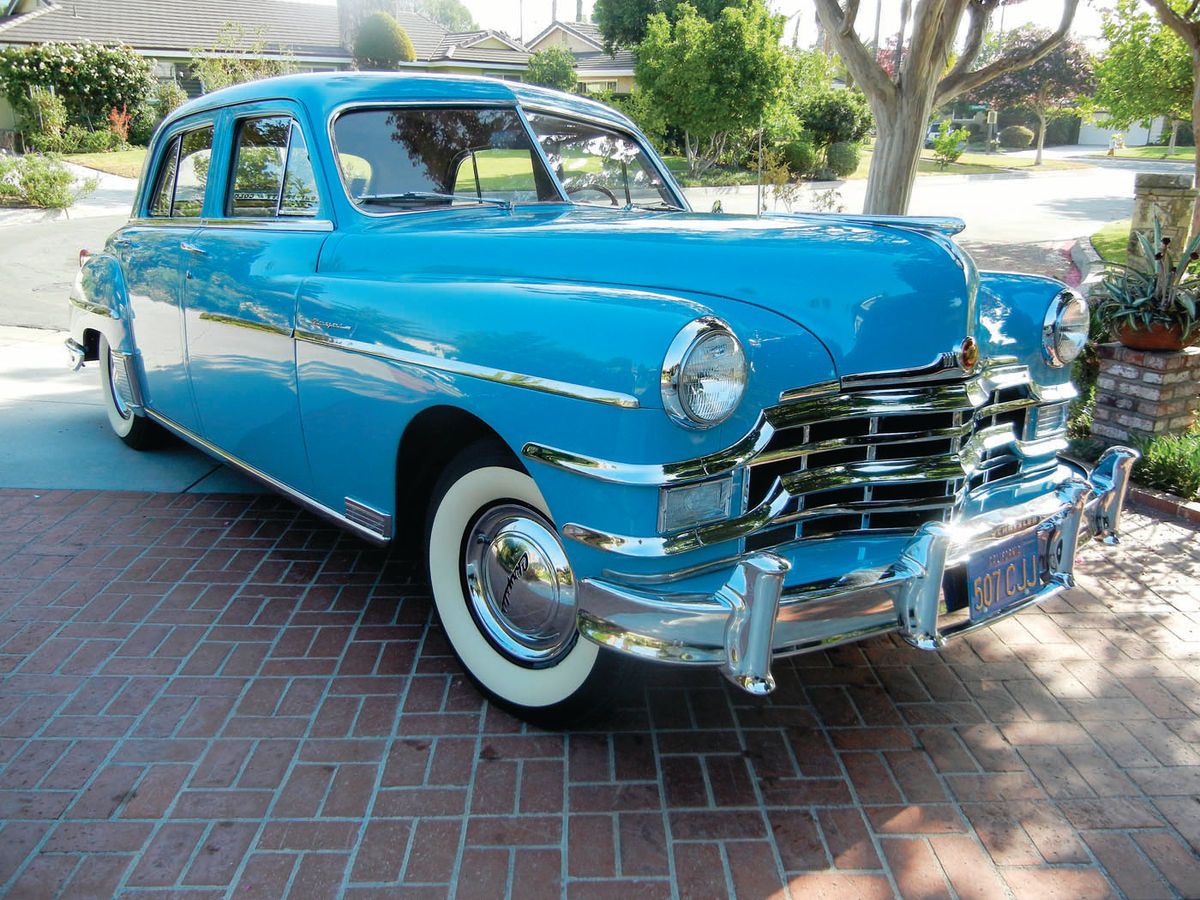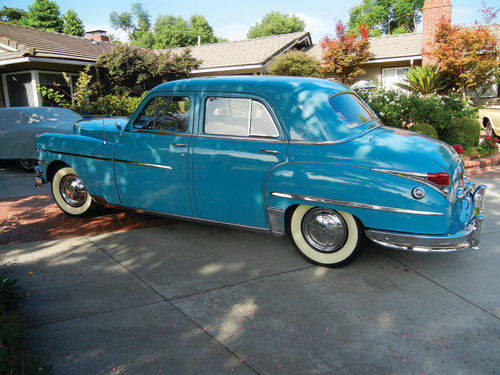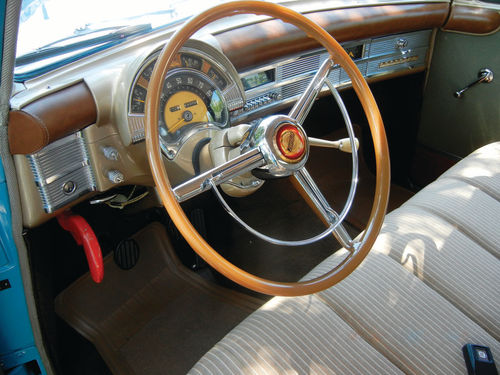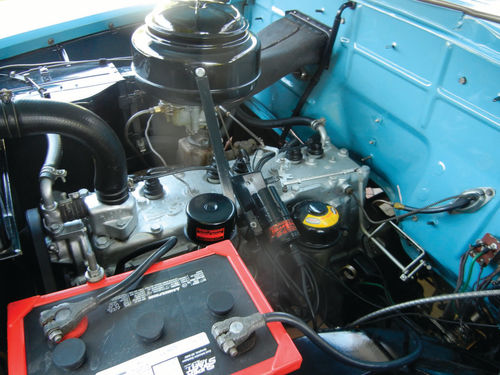1949 Chrysler Royal: Classic with a hot running 6 cylinder engine
Having a Chrysler Royal In His Life Since 1949 Has Taught This Reader About Dealing With Hot-Running Engines… and the Pleasures of Owning and Driving a Very Special Ride.

Editor’s note: In the February Mechanic on Duty an entry titled “Solutions for a hot-running Dodge” came from a reader who said his 1950 Dodge had been running hot so he drained the cooling system and put in fresh water and coolant and replaced the thermostat. But after that, he stated, “it just runs hotter now and overheats while waiting at long signal lights.” A number of readers have written in with their opinions and experiences including John McMahon whose family has owned a 1949 Chrysler since it was new. In this account, John has shared his thoughts on dealing with cooling issues along with telling us what it’s like to own a car for that long period of time. Here’s John:
My dad bought a 1949 Chrysler Royal 6-cylinder new and I inherited it in 1959. I drove it as regular transportation from 1959 to 1980, restored it from 1980 to 1988, and have driven it every couple of weeks since then. The car was in Colorado from 1949 to 1971 except for two years in New York City in the mid-1960s and has been in Southern California since 1971, so I have both cold- and warm-climate first-hand experiences to share regarding heating and coolant issues with Mopar flatheads.
My dad changed coolant twice a year, using water with an anti-rust agent for the frost-free months and an antifreeze mixture during the cold months as recommended in the original factory shop manual. This worked well and helped keep the cooling system clean as an extra benefit. As to running without a thermostat, the car will definitely run cooler regardless of weather. I ran it that way for a time as it had cooling issues I temporarily solved that way. I later discovered the real problem (see the next paragraph) when I rebuilt the engine. FYI, the factory shop manual specifies a thermostat that starts to open at 157 to 162 degrees and is fully open at 183 degrees. The factory thermostat has by-pass slots that must be correctly oriented to allow flow through the by-pass hose. This is relevant for cars equipped with the deluxe heater systems.

Consider the Water Distribution Tube
The obvious approaches to a hot-running engine (radiator, thermostat, timing, water pump, etc.) have been detailed in your previous articles. But the one persistent issue with these engines is the water distribution tube. If it rusts out or clogs, the coolant does not get to the rear cylinders unimpeded. The temperature gauge tube screws in toward the rear of the engine and thus may be indicating this issue.
The only way to check is to remove the water pump and inspect the tube. The tube can usually be removed with a hook and slidehammer, but if it’s severely corroded, it may be necessary to remove the cylinder head to allow tube access with penetrating oil through the water passages in the top of the block. Since the tube is as long as the block, the radiator must be out of the car and possibly the grille as well.
Considering the Available Coolants
The perfect fluid would be efficient at heat transfer, would offer freeze protection, and be non-toxic, cheap and non-corrosive. The following brief summary of available cooling fluids addresses these concerns:
* Water—Pros: by far the most efficient at heat transfer, both in absorbing heat in the engine and in expelling heat through the radiator. Non-toxic and cheap. (It’s preferable to use distilled or filtered water.) Cons: It’s corrosive without an effective anti-rust additive. There’s no freeze protection.
* Ethylene Glycol—Pros: More costly than water, but certainly not expensive. It protects against freezing. While it does raise the boiling point, this is only relevant in modern automobiles as a raised engine temperature is not desirable in older cars. Cons: A 15% reduction in heat transfer rate compared to water. Corrosive without effective corrosion inhibitors. Highly toxic to small creatures (children, dogs, cats, squirrels, rabbits, etc.), who are attracted by the sickly sweet odor and taste. Requires hazardous waste disposal due to toxicity.
* Propylene Glycol—Pros: So nontoxic that it is federally approved as a food additive! More costly than water, but certainly not expensive. Protects against freezing. While it does raise the boiling point, again this is only relevant in modern automobiles as a raised engine temperature is not desirable in the older cars. Cons: A 3% lower heat transfer rate than ethylene glycol, but otherwise performs similarly. Corrosive without effective corrosion inhibitors. Difficult to find, although Prestone markets a propylene glycol antifreeze as does Peak with their Sierra brand. Others may also. You need to request that your parts store stock this.

One final issue exists with both antifreeze solutions: they have a higher viscosity than water alone. Your water pump will either work harder to move the same amount of fluid or will move less fluid.
For a good description of the tradeoff between cooling efficiency and freeze protection, see “Dispelling the Myths of Heat Transfer Fluids” by the Dow Chemical Co., which is available online. This concentrates on industrial uses rather than automotive, but is technically very complete.
I believe that newer cars should use a 50-50 blend of propylene glycol due to its non-toxicity. Ethylene glycol mixes will work fine and are OK as long as the cooling system remains properly sealed, but why are we overwhelmed with toxic anti-freeze when a non-toxic equivalent is available?I believe that newer cars should use a 50-50 blend of propylene glycol due to its non-toxicity. Ethylene glycol mixes will work fine and are OK as long as the cooling system remains properly sealed, but why are we overwhelmed with toxic anti-freeze when a non-toxic equivalent is available?
Moreover, most old cars do not have closed systems and may dump some amount of coolant after a long hot run. For this reason alone, they should not use ethylene glycol antifreeze unless the owner is careful to immediately wipe up any overflow spill.

If the car is located in frost-free areas or is always in a heated garage, then water + rust resistor is the safest and most efficient coolant. If the car may be subject to freezing temperatures, then a 50-50 propylene glycol mix is safe for the car and the environment. The reduced heat transfer is unlikely to be a problem during the colder times of the year and the car can be returned to water + rust resistor in the spring.
I hope this helps the Dodge owner and others who are concerned with similar issues.
Now, When That ’49 Chrysler Was New…
“It’s about time we got a new car,” my sister Kathy excitedly exclaimed when our parents Denny and Lillian McMahon brought home a new 1949 Chrysler Royal from Majestic Motors in Englewood, Colorado.
I was about six years old then and obviously didn’t realize the importance this event would hold for me in the future.
After being shortened to “Itsabout,” my sister’s exclamation became the car’s name. My dad had wanted a Chrysler since Walter P. made the first one in 1924 and he finally found his “dream machine” at the end of 1949.
Itsabout is equipped with a 116-horsepower, 250.6-cubic-inch flathead six and 3-speed standard transmission without fluid drive (rare for a Chrysler).
Some 10 years later, I inherited Itsabout from my then-widowed mom and drove it throughout high school.

One summer, since Itsabout was blowing blue smoke, I decided to overhaul the engine. In that era, a mobile machinist would come to your location and do ridge reaming, glaze busting and valve grinding with the engine in the car and the car in the driveway. With new rings and bearing inserts, the smoke disappeared! This being the first major car work of my life, I hooked the coil up with wires reversed (weird symptoms), but otherwise the car ran properly. I had a few small leftover parts (mostly fasteners) that I have never figured out.
This Mopar Traveled Many Miles…Sometimes As an SUV
Itsabout served as a daily transport, fishing wagon and mountain explorer (an early term for an SUV) for the next 12 years. It nicely negotiated many roads listed on maps as “inquire locally.” (The list includes Corona [Rollins], Slumgulion, Scofield, Kebler, & Ohio Passes, Hamlin Gulch, James Peak, and many more.)
Itsabout often was the only passenger sedan on roads where normally only trucks and 4-wheel-drives can roam. It still has the dent in the frame from being high-centered and once experienced the indignity of its ignition being flooded out when I hit a river ford too quickly. (Ever had a “river runs through it” in your car?) Sometimes we would go exploring in my friend’s 1951 Buick Super or my cousin’s 1952 Ford 6, both of which were rugged for the various dirt roads, but the Ford was low on the torque required to negotiate some steeper grades.
When I went to Columbia (New York City) for college in 1961/2, Itsabout sat unused during two school years but got back in the mountains during the summer. After realizing many of my Columbia friends did not have a car and never drove, I offered to take six Columbia students (I was the only one with a driver’s license) to Maine for a total eclipse of the sun in the summer of 1963. The exhausting journey involved a more than 1000-mile round trip in 48 hours. The eclipse remains one of the most impressive sights I have ever seen.
Thereafter, I drove it cross-country to New York and back to Colorado several times. Itsabout returned to Colorado for a few years but moved with me to Southern California in 1971 when I got a civil engineering job in Los Angeles. We have both lived in Southern California ever since.
A Chance Encounter Led to Its Restoration
Itsabout commuted around L.A. until 1979, but by then it had many issues and so it sat seldom-used in the driveway.
One day a gentleman with a dismantled 1949 Windsor knocked on my door. He had been injured and could not continue a planned bodyoff restoration of his car. Even though the Windsor was scattered to four different locations, it provided parts that motivated me to do a restoration. Much of the Windsor is now spares for any eventuality.
I did not expect that the restoration eventually would consume nine years. I did the mechanical, body, paint and upholstery myself, repaying Itsabout’s years of faithful service.
I had a new wiring harness made (the old hard rubber insulation literally fell off during removal) and had new flat glass made. Reproduction weatherstrips were all available. I located NOS lenses for the entire car, but had to modify an extra horn button to replace the cracked and crazed plastic hood front emblem. Several years later I located an NOS emblem, now on the car. I retained the original 6-volt positive ground system and it performs flawlessly.

It’s Drawn Attention at Shows…and At My Wedding
Within a couple of days of the project’s completion, I drove it to a car show and came home with the “Best of Show” trophy. But while trophies are nice (Itsabout has acquired over a dozen), the real fun is in driving around, seeing the sights and collecting numerous thumbsup. In the year 2000, my sister Kathy’s husband Glenn drove me in Itsabout to pick up my bride for our wedding. The shining blue car was decorated with pink flowers and white netting.
We gathered lots of admiring looks during that drive…without knowing if they were for the bridal couple or my car.
After 50 years, my Itsabout once again had taken me on an important journey in my life. Now, at age 67, Itsabout leads a double life as my wife and I occasionally drive it to cruise around town and it has a practical side as I use it to run errands.
Some Notes On 1949 Chryslers
The Royal was a car we would call a “loss leader” today, allowing Chrysler to advertise an MSRP of only $2154. It used the Plymouth 3-speed transmission instead of Prestomatic and had a simple flywheel in lieu of Fluid Drive. However, most Royal buyers chose the semiautomatic and I have only seen two others without Fluid Drive (one in a junkyard) in all the years, easily determined by the presence or lack of the “Fluid Drive” lettering on the trunk, something I knew and noticed from age 6 on.
The Royal also came with only a single center bumper guard in front, whereas all other models had two offcenter guards integral with a license guard. The Windsor parts car license guard and bumper guards are now on my Royal.
Of course a radio, clock and heater were extra-cost options, but fortunately they were present on my car. The Royal had only one dashboard ash receiver (there were two on other models) and had a rubber front floor mat (carpet was optional). It also was relatively light for its day with a published weight of only 3550 pounds.















